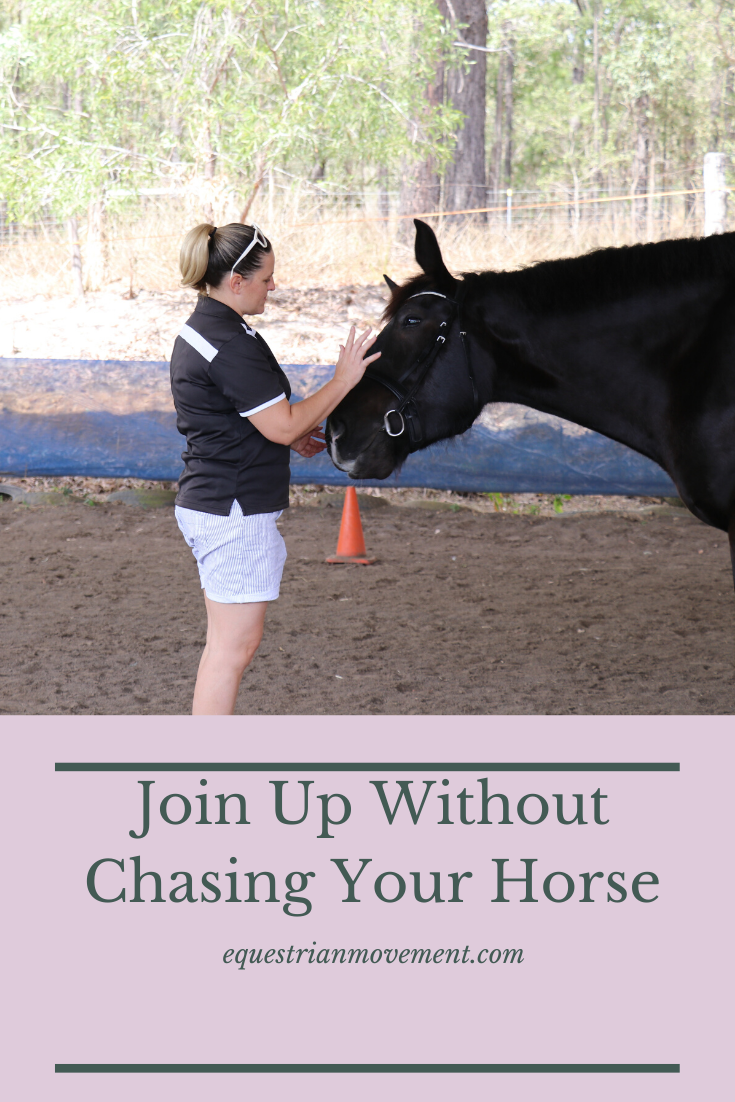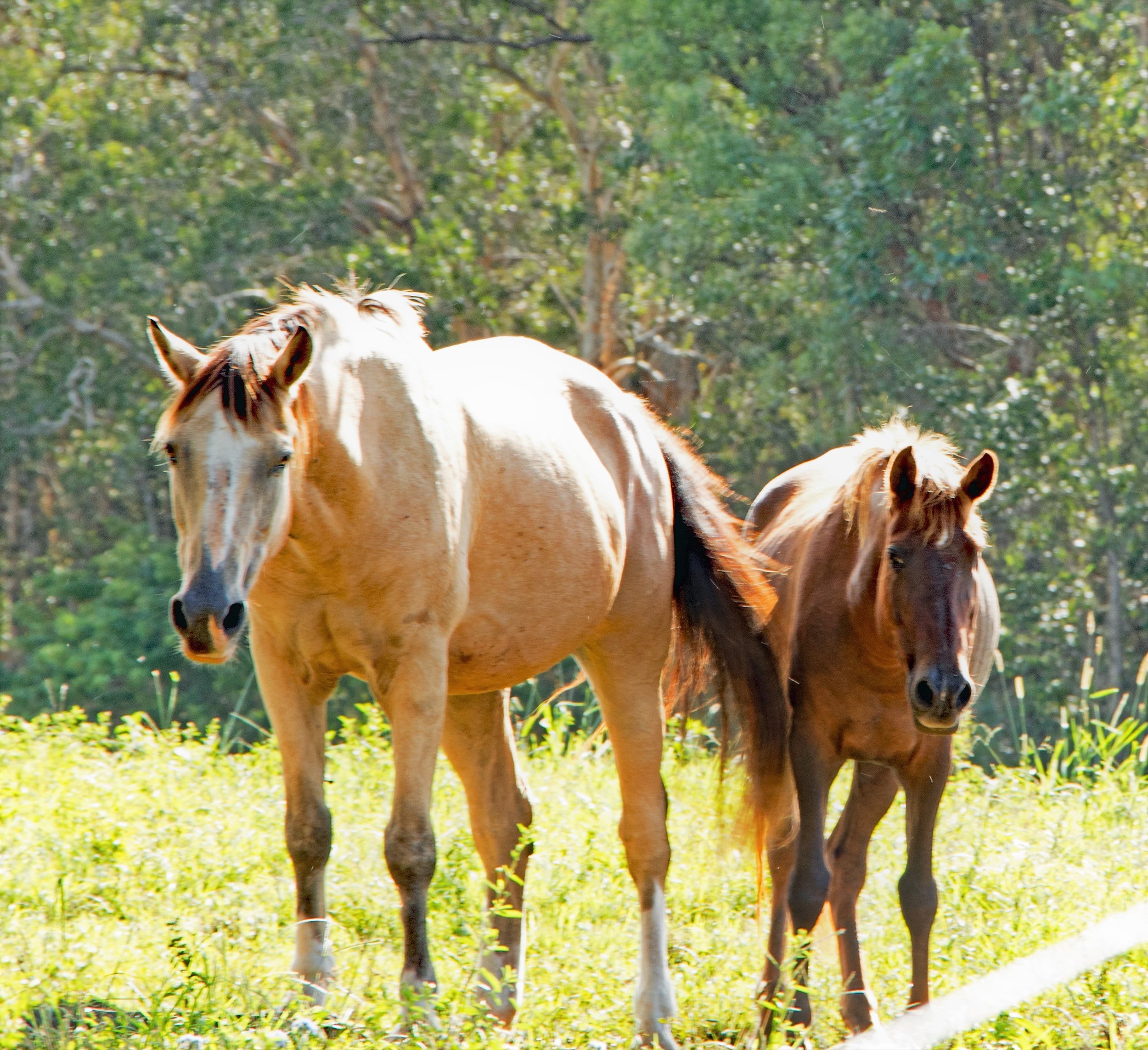How to get your horse to “join up” without chasing your horse into submission
Why we are not in love with the Join Up process.
As horse riders on the journey we are all seeking the moment of utter magic and joy, where our horse connects with us on a deeper level emotionally.
The moment where they stop arguing with us, pushing us around, trying to run away from us.
That moment of union where it’s like you are your horse move and think as one.
Join up is often recommended to establish this connection. It is touted as the way to handle your horse without violence and to develop a bond. However, after years of breaking, training and playing around with different groundwork principles, I believe there is a better way.
What is join up
Join up is where you free lunge your horse in a round yard.
You keep the horse moving forward until you see loud, over exaggerated and multiple relaxation cues (Read more about relaxation cues here).
The premise being that when you horse shows these signs of submission they are ready to approach you and bond with you. When you are free lunging your horse you are wanting them to change direction by turning into you not away from you. This also encourages the join up process.
Why this works
It gets the zoomies out.
We honestly expect a lot more of our horses than we do of other animals. Because they are so big and we want to sit on them we expect a naturally flighty animal to be unflappable (get it cause they’re often scared of flappy plastic bags). We not only expect them to be cool, calm and collected in all environments but we also want them to be steady and balanced when they work no matter what kind of performance pressure we put on them.
Behaviours that are perfectly acceptable from other animals (i.e. the zoomies) are considered naughty when done by horses. Sometimes they just need a good run to get the spunk out of their system and then they can concentrate and work again. Join up can let our horses have a good run and a buck and warm their back up before settling into focus and work.
Horses learn from the release of pressure. Whatever a horse is consistently doing when you take the pressure off them they will learn to do. So if you take the pressure of the lunge whip off when your horse shows relaxation cues, or calmly approaches you, they will learn to give multiple, loud relaxation cues and approach you calmly… eventually so they don’t have to lunge anymore.
So used correctly this can be a handy skill to have and know how to use but it doesn’t establish a bond with your horse. It can be a useful way to allow your horse to get its pent up energy out of its system so it can calmly approach you and better control its emotions.
And a horse that can’t control its emotions, can’t control its behaviour.
Why we don’t love it
It doesn’t teach horses how to process their emotions.
Just running the energy out of them so that they can focus doesn’t teach them how to shift their emotional state.
So if they are cooperating because they are scared, confused, frustrated anxious etc, it only teaches them how to process emotion (fight or flighty hormones) by running - which is not necessarily what we need to teach a flight animal. More so we are taking advantage of the horses natural way of processing fight or flight hormones by running. The fitter we make our horses the longer it takes to get those relaxation cues and we end up making our horses fitter than us.
It works off the idea of submission.
While at equestrian movement we start with leadership (i.e. me boss you follower), we like to try and move quickly into a partnership.
We also establish leadership with clear, consistent boundaries and following through on our asks. Not chasing our horses until they quit (FYI this is also why join up works). You are clear and consistent on what you want the horse to do and what will happen to them when they do it. There are clear consequences to their behaviour and it is followed through on.
So what is thought of as a bond establishing it really is just the horse learning what to do with pressure and how to find the release (don’t believe me? Check out this study where they were able to get the same join up results with a remote control car. https://thehorse.com/118284/remote-controlled-cars-used-to-study-round-pen-training/)
You don’t have to chase your horse to establish a connection with your horse and get them to “join up” or “hook on”
Showing up as a good leader, establishing clear, consistent expectations, following through on your asks, being clear in your expectations and consequences and over time you will develop trust, respect and a relationship. Want to speed the process along? We cover how to establish the connection without join up in our Easy Peasy Liberty Module of Training trainability.
How strong is your bond with your horse? Take our quiz!!
Take our quiz and see what you might need to work on to improve the relationship you have with your horse.
Developing A Bond With Your Horse
Is this your goal?
We recently hosted a free workshop in our Facebook group with exercises that helped to develop a stronger bond with our horses.
To be honest, I was surprised by the number of people that joined because they wanted a stronger bond with their horse (which I’m stoked about). I was expecting people to join the workshop wanting to fix certain problems they were having with their horses.
And it got me thinking: I have my understanding of what I want in a bond and a relationship - but what do others expect?
What is a bond?
A bond is stronger than just liking someone. But we do have to start there. We have to like our horses and they have to like us. Liking each other, enjoying each others company and wanting to spend time together fosters an environment where a bond and a relationship can be born.
A bond with another is built on social connection and nurturing the emotional needs of the individuals. These emotions include trust, affection, gratitude and love amongst others. As we build trust and feel safe that they won’t hurt us, we break down our emotional boundaries. The trust and social connection established in a bond make us feel valued, loved and cared for.
Training and developing a relationship or a bond go hand in hand whilst also being polar opposites. You can have a trained, well behaved horse without nurturing their emotional needs, and you can have a relationship without our horse being educated and responding correctly to our asks. Training, our goals and our expectations can easily damage our relationship and bond with our horses if we aren’t respectful of our horses’ emotional needs.
Asking our horse to do something that is scary or putting them in a situation that they may get hurt.
Not listening to them when they say “I’m overwhelmed”, “I’m scared”, “I need a break”.
Using force to get what we want from them even if why we are getting it is because they don’t understand or can’t do.
Expecting them to bring their ‘A’ game every ride and be better than their last even when we aren’t as riders.
All these things can damage our relationship with our horse and create undesirable behaviours in our horse or lead them to shutting us out and just performing the task asked without enjoying it.
As easy as it is to breakdown this relationship, it’s just as hard to build a strong healthy relationship and bond. A bond is created through times of difficulty or hardship. Have you ever had a horse that you have nurtured while sick or injured and noticed after they recovered that the relationship had strengthened? Being able to guide a horse through a difficult experience safely so that it becomes a positive experiences helps us to show up as leaders and our horses to learn to trust us. The other way is just spending time together and offering a company.
This is why the workshop was based on small, easy to implement exercises done consistently. This is why we harp on having the same expectations of our horse every time we handle them, no matter how time poor we are. So that when we put them in more challenging exercises or experiences they trust us and know what is expected on them. We stop feeling like we could have done more on a positive note without overfacing them. Because each interaction with our horse is first to build this trust, relationship and bond and then secondly to work towards our goals.
If you want to join us for our next workshop, make sure you are on our email list by signing up below!
From Abandoned To Forever Home: Story Of A Rescue Horse
How patience and love can impact more than one life
Custard and his beautiful paddock mate
Sometimes I have to wonder on the life of horses.
So many of our horses have unknown histories, suffering anything from a simple lack of love to cruelty beyond imagining. Sometimes this is intentional (#$%@) and sometimes, not so much.
I wanted to take the chance to share with you the story of my boy, Custard.
Custard, who at this stage was a more mature horse (around 17 or 18 years) had been agisted in a friends paddock for many years before he became mine. Very little was known of his history apart from that he was a trail riding horse. As can happen, when he was no longer needed by his former owners, he was offered up for sale, but through no fault of his own, would end up returning to them again.
It was the final straw for my friend when he was offered up as a ‘free to good home’ horse.
“You know what happens to those horses,” she said to me, “I can’t bear to see that happen to him.”
And so Custard became a part of her herd. That single statement changed his life.
Firstly, he started to thrive on an established routine, which included regular feeding, treats and bonding with a paddock mate. However, he still remained ‘distant’ from human interaction - he would accept interaction that he had to endure but would quickly and quietly move on once completed.
Just over a year ago, this same friend allowed me the opportunity to start working with Custard. Boy, did we have a lot to work on, and a lot to work with.
It’s taken a lot of effort and a fair amount of time, but Custard has progressed from a timid, stressed horse that was disinterested in people, struggling with a lack of confidence when he was separated from his paddock mate, to becoming a loving, affectionate and confident horse that tries to help his rider out - even when she isn’t performing at her best.
It took giving him a voice, establishing a bond and a lot of love and attention (plus a fair number of treats and massages) for me to get that very first welcome whinny that makes it all worth the effort. He has become my peace and I have become his human. Custard has his forever home.
Do you have a rescue story? Share it in the comments below!
Looking for more specific content?
Have a question you are seeking answers to? Send us a message and we will create a blog!












Free online workshop